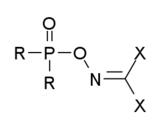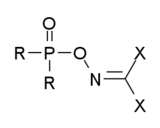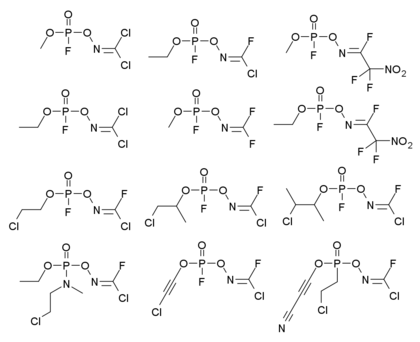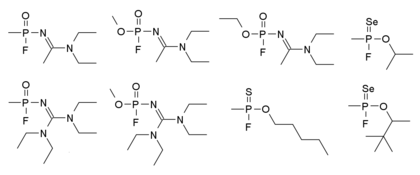
Novichok agent
Encyclopedia
Novichok is a series of nerve agents that were developed by the Soviet Union
in the 1970s and 1980s and allegedly the most deadly nerve agents ever made, with some variants possibly five to eight times more potent than VX
, though this has never been proven. They belong to "fourth generation chemical weapons" designed as a part of Soviet "Foliant" program. Initially designated K-84 and later renamed A-230. The Novichok family of analogs comprises more than a hundred structural variants. Of all the variants the most promising, from a military standpoint, was A-232 (Novichok-5).
Although all these objectives were claimed to have been achieved, this is yet to be proven.
Some of these agents are binary weapons
, in which precursors for the nerve agents are mixed in a munition to produce the agent just prior to its use. Because the precursors are generally significantly less hazardous than the agents themselves, this technique makes handling and transporting the munitions a great deal simpler. Additionally, precursors to the agents are usually much easier to stabilize than the agents themselves, so this technique also made it possible to increase the shelf life
of the agents. However this has the disadvantage that careless preparation or preparation by untrained individuals may produce a non-optimal agent. During the 1980s and 1990s, binary versions of several Soviet agents were developed and are designated as "Novichok" agents (after the Russian word for "newcomer").
weekly in 1992. The publication appeared just on the eve of Russia's signing of the Chemical Weapons Convention
. According to Mirzayanov, the Russian Military Chemical Complex (MCC) was using defense conversion money received from the West for development of a chemical warfare facility. Mirzoyanov made his disclosure out of environmental concerns. He was a head of a counter-intelligence department and performed measurements outside the chemical weapons facilities to make sure that foreign spies could not detect any traces of production. To his horror, the levels of deadly substances were 80 times greater than the maximum safe concentration. (A full account by Mirzayanov is available online.)
The existence of Novichok agents was openly admitted by Russian military industrial complex authorities when they brought a treason
case against Mirzayanov. According to expert witness testimonies prepared for the KGB
by three scientists, novichok and other related chemical agents had indeed been produced and therefore the disclosure by Mirzoyanov represented high treason
.
Vil Mirzayanov was arrested on October 22, 1992 and sent to Lefortovo prison
for divulging state secrets. He was released later because "not one of the formulas or names of poisonous substances in the Moscow News article was new to the Soviet press, nor were locations ... of testing sites revealed." According to Yevgenia Albats
, "the real state secret
revealed by Fyodorov and Mirzayanov was that generals had lied — and were still lying — to both the international community and their fellow citizens." He now lives in the U.S.
instead of a gas or a vapor, they have unique qualities. A binary agent
was then created that would mimic the same properties but would either be manufactured using materials legal under the CWT or be undetectable by treaty regime inspections. The most potent compounds from this family, novichok-5 and novichok-7, are supposedly around 5-8x more potent than VX
, however the exact structures of these compounds have not been reliably verified.
One of the key manufacturing sites was a chemical research institute in what is now Uzbekistan
, and small, experimental batches of the weapons may have been tested on the nearby Ustyurt plateau
.
Two broad families of organophosphorus agents have been claimed to be Novichok agents. First are a group of organophosphorus
compounds with an attached dihaloformaldoxime group, with the general formula shown below, where R = alkyl, alkoxy, alkylamino or fluorine
and X = halogen
(F
, Cl
, Br
) or pseudohalogen
such as C≡N
. These compounds are extensively documented in Soviet literature of the time, but it is unclear whether they are in fact the potent "Novichok" compounds.

Some examples of the first group of compounds reported in the literature are shown below, but it is unknown whether any of these is novichok-5 or novichok-7.

Mirzayanov gives somewhat different structures for Novichok agents in his autobiography, as shown below. He makes clear that a large number of compounds were made, and many of the less potent derivatives reported in the open literature as new organophosphate insecticides, so that the secret chemical weapons program could be disguised as legitimate pesticide research.

acetylcholinesterase inhibitor
s. These chemical compounds inhibit the enzyme acetylcholinesterase
, preventing the normal breakdown of neurotransmitter
acetylcholine
. Acetylcholine concentrations then increase at neuromuscular junctions to cause involuntary contraction of all muscles. This then leads to respiratory and cardiac arrest and finally death. The use of a fast-acting peripheral anticholinergic
drug such as Atropine
could block the receptors where acetylcholine acts to prevent poisoning (as is the treatment for poisoning by other acetylcholinesterare inhibitors). This is however quite dangerous in itself.
Soviet Union
The Soviet Union , officially the Union of Soviet Socialist Republics , was a constitutionally socialist state that existed in Eurasia between 1922 and 1991....
in the 1970s and 1980s and allegedly the most deadly nerve agents ever made, with some variants possibly five to eight times more potent than VX
VX (nerve agent)
VX, IUPAC name O-ethyl S-[2-ethyl] methylphosphonothioate, is an extremely toxic substance whose only application is in chemical warfare as a nerve agent. As a chemical weapon, it is classified as a weapon of mass destruction by the United Nations in UN Resolution 687...
, though this has never been proven. They belong to "fourth generation chemical weapons" designed as a part of Soviet "Foliant" program. Initially designated K-84 and later renamed A-230. The Novichok family of analogs comprises more than a hundred structural variants. Of all the variants the most promising, from a military standpoint, was A-232 (Novichok-5).
Design objectives
These agents were designed to achieve three objectives:- To be undetectable using standard NATO chemical detection equipment
- To defeat NATO chemical protective gear
- To be safer to handle
Although all these objectives were claimed to have been achieved, this is yet to be proven.
Some of these agents are binary weapons
Binary chemical weapon
Binary chemical weapons or munitions are chemical weapons wherein the toxic agent is not contained within the weapon in its active state, but in the form of two chemical precursors, physically separated within the weapon...
, in which precursors for the nerve agents are mixed in a munition to produce the agent just prior to its use. Because the precursors are generally significantly less hazardous than the agents themselves, this technique makes handling and transporting the munitions a great deal simpler. Additionally, precursors to the agents are usually much easier to stabilize than the agents themselves, so this technique also made it possible to increase the shelf life
Shelf life
Shelf life is the length of time that food, drink, medicine, chemicals, and many other perishable items are given before they are considered unsuitable for sale, use, or consumption...
of the agents. However this has the disadvantage that careless preparation or preparation by untrained individuals may produce a non-optimal agent. During the 1980s and 1990s, binary versions of several Soviet agents were developed and are designated as "Novichok" agents (after the Russian word for "newcomer").
Disclosure
Extremely potent third-generation chemical weapons were developed in the Soviet Union and Russia from the 1970s until the early 1990s, according to a publication by two chemists, Lev Fedorov and Vil Mirzayanov in Moskovskiye NovostiMoskovskiye Novosti
Moskovskiye Novosti will be a daily newspaper in Russia to be relaunched in 2011.It was previously a long-established weekly newspaper aimed at an educated, elite audience. In 2005-2008 it was owned by Arcadi Gaydamak. It is published in the Russian language...
weekly in 1992. The publication appeared just on the eve of Russia's signing of the Chemical Weapons Convention
Chemical Weapons Convention
The Chemical Weapons Convention is an arms control agreement which outlaws the production, stockpiling and use of chemical weapons. Its full name is the Convention on the Prohibition of the Development, Production, Stockpiling and Use of Chemical Weapons and on their Destruction...
. According to Mirzayanov, the Russian Military Chemical Complex (MCC) was using defense conversion money received from the West for development of a chemical warfare facility. Mirzoyanov made his disclosure out of environmental concerns. He was a head of a counter-intelligence department and performed measurements outside the chemical weapons facilities to make sure that foreign spies could not detect any traces of production. To his horror, the levels of deadly substances were 80 times greater than the maximum safe concentration. (A full account by Mirzayanov is available online.)
The existence of Novichok agents was openly admitted by Russian military industrial complex authorities when they brought a treason
Treason
In law, treason is the crime that covers some of the more extreme acts against one's sovereign or nation. Historically, treason also covered the murder of specific social superiors, such as the murder of a husband by his wife. Treason against the king was known as high treason and treason against a...
case against Mirzayanov. According to expert witness testimonies prepared for the KGB
KGB
The KGB was the commonly used acronym for the . It was the national security agency of the Soviet Union from 1954 until 1991, and was the premier internal security, intelligence, and secret police organization during that time.The State Security Agency of the Republic of Belarus currently uses the...
by three scientists, novichok and other related chemical agents had indeed been produced and therefore the disclosure by Mirzoyanov represented high treason
High treason
High treason is criminal disloyalty to one's government. Participating in a war against one's native country, attempting to overthrow its government, spying on its military, its diplomats, or its secret services for a hostile and foreign power, or attempting to kill its head of state are perhaps...
.
Vil Mirzayanov was arrested on October 22, 1992 and sent to Lefortovo prison
Lefortovo prison
Lefortovo prison is a prison in Moscow, Russia, which, since 2005, has been under the jurisdiction of the Ministry of Justice of the Russian Federation. It was built in 1881...
for divulging state secrets. He was released later because "not one of the formulas or names of poisonous substances in the Moscow News article was new to the Soviet press, nor were locations ... of testing sites revealed." According to Yevgenia Albats
Yevgenia Albats
Dr. Yevgenia Markovna Albats is a Russian investigative journalist, political scientist, writer and radio host. As of year 2011, she workes as a chief editor of The New Times magazine.-Early life and education:...
, "the real state secret
State Secret
State Secret is a 1950 British drama film directed by Sidney Gilliat and starring Douglas Fairbanks Jr., Jack Hawkins, Glynis Johns and Herbert Lom. It was released in the United States under the title The Great Manhunt.-Cast:...
revealed by Fyodorov and Mirzayanov was that generals had lied — and were still lying — to both the international community and their fellow citizens." He now lives in the U.S.
Description of Novichok agents
The first description of these agents was provided by Mirzayanov. Dispersed in an ultra-fine powderAerosol
Technically, an aerosol is a suspension of fine solid particles or liquid droplets in a gas. Examples are clouds, and air pollution such as smog and smoke. In general conversation, aerosol usually refers to an aerosol spray can or the output of such a can...
instead of a gas or a vapor, they have unique qualities. A binary agent
Binary chemical weapon
Binary chemical weapons or munitions are chemical weapons wherein the toxic agent is not contained within the weapon in its active state, but in the form of two chemical precursors, physically separated within the weapon...
was then created that would mimic the same properties but would either be manufactured using materials legal under the CWT or be undetectable by treaty regime inspections. The most potent compounds from this family, novichok-5 and novichok-7, are supposedly around 5-8x more potent than VX
VX (nerve agent)
VX, IUPAC name O-ethyl S-[2-ethyl] methylphosphonothioate, is an extremely toxic substance whose only application is in chemical warfare as a nerve agent. As a chemical weapon, it is classified as a weapon of mass destruction by the United Nations in UN Resolution 687...
, however the exact structures of these compounds have not been reliably verified.
One of the key manufacturing sites was a chemical research institute in what is now Uzbekistan
Uzbekistan
Uzbekistan , officially the Republic of Uzbekistan is a doubly landlocked country in Central Asia and one of the six independent Turkic states. It shares borders with Kazakhstan to the west and to the north, Kyrgyzstan and Tajikistan to the east, and Afghanistan and Turkmenistan to the south....
, and small, experimental batches of the weapons may have been tested on the nearby Ustyurt plateau
Ustyurt Plateau
The Ustyurt Plateau, also spelled Ust-Yurt, Ust-Urt and Usturt , is a central Asian plateau in Uzbekistan and Kazakhstan, between the Aral Sea and the Caspian Sea. It extends roughly 200,000 km², with an average elevation of 150 meters, and consists primarily of stony desert...
.
Two broad families of organophosphorus agents have been claimed to be Novichok agents. First are a group of organophosphorus
Organophosphorus
Organophosphorus compounds are degradable organic compounds containing carbon–phosphorus bonds , used primarily in pest control as an alternative to chlorinated hydrocarbons that persist in the environment...
compounds with an attached dihaloformaldoxime group, with the general formula shown below, where R = alkyl, alkoxy, alkylamino or fluorine
Fluorine
Fluorine is the chemical element with atomic number 9, represented by the symbol F. It is the lightest element of the halogen column of the periodic table and has a single stable isotope, fluorine-19. At standard pressure and temperature, fluorine is a pale yellow gas composed of diatomic...
and X = halogen
Halogen
The halogens or halogen elements are a series of nonmetal elements from Group 17 IUPAC Style of the periodic table, comprising fluorine , chlorine , bromine , iodine , and astatine...
(F
Fluorine
Fluorine is the chemical element with atomic number 9, represented by the symbol F. It is the lightest element of the halogen column of the periodic table and has a single stable isotope, fluorine-19. At standard pressure and temperature, fluorine is a pale yellow gas composed of diatomic...
, Cl
Chlorine
Chlorine is the chemical element with atomic number 17 and symbol Cl. It is the second lightest halogen, found in the periodic table in group 17. The element forms diatomic molecules under standard conditions, called dichlorine...
, Br
Bromine
Bromine ") is a chemical element with the symbol Br, an atomic number of 35, and an atomic mass of 79.904. It is in the halogen element group. The element was isolated independently by two chemists, Carl Jacob Löwig and Antoine Jerome Balard, in 1825–1826...
) or pseudohalogen
Pseudohalogen
Pseudo'halogen molecules are inorganic molecules of the general formsPs–Ps or Ps–X, where Ps is a pseudohalogen group such as cyanide, cyanate, thiocyanate and others, and X is a "true" halogen...
such as C≡N
Cyanide
A cyanide is a chemical compound that contains the cyano group, -C≡N, which consists of a carbon atom triple-bonded to a nitrogen atom. Cyanides most commonly refer to salts of the anion CN−. Most cyanides are highly toxic....
. These compounds are extensively documented in Soviet literature of the time, but it is unclear whether they are in fact the potent "Novichok" compounds.

Some examples of the first group of compounds reported in the literature are shown below, but it is unknown whether any of these is novichok-5 or novichok-7.

Mirzayanov gives somewhat different structures for Novichok agents in his autobiography, as shown below. He makes clear that a large number of compounds were made, and many of the less potent derivatives reported in the open literature as new organophosphate insecticides, so that the secret chemical weapons program could be disguised as legitimate pesticide research.

Effects
As a nerve agent, Novichok belongs to organophosphateOrganophosphate
An organophosphate is the general name for esters of phosphoric acid. Phosphates are probably the most pervasive organophosphorus compounds. Many of the most important biochemicals are organophosphates, including DNA and RNA as well as many cofactors that are essential for life...
acetylcholinesterase inhibitor
Acetylcholinesterase inhibitor
An acetylcholinesterase inhibitor or anti-cholinesterase is a chemical that inhibits the cholinesterase enzyme from breaking down acetylcholine, increasing both the level and duration of action of the neurotransmitter acetylcholine.- Uses :Acetylcholinesterase inhibitors:* Occur naturally as...
s. These chemical compounds inhibit the enzyme acetylcholinesterase
Cholinesterase
In biochemistry, cholinesterase is a family of enzymes that catalyze the hydrolysis of the neurotransmitter acetylcholine into choline and acetic acid, a reaction necessary to allow a cholinergic neuron to return to its resting state after activation.-Types:...
, preventing the normal breakdown of neurotransmitter
Neurotransmitter
Neurotransmitters are endogenous chemicals that transmit signals from a neuron to a target cell across a synapse. Neurotransmitters are packaged into synaptic vesicles clustered beneath the membrane on the presynaptic side of a synapse, and are released into the synaptic cleft, where they bind to...
acetylcholine
Acetylcholine
The chemical compound acetylcholine is a neurotransmitter in both the peripheral nervous system and central nervous system in many organisms including humans...
. Acetylcholine concentrations then increase at neuromuscular junctions to cause involuntary contraction of all muscles. This then leads to respiratory and cardiac arrest and finally death. The use of a fast-acting peripheral anticholinergic
Anticholinergic
An anticholinergic agent is a substance that blocks the neurotransmitter acetylcholine in the central and the peripheral nervous system. An example of an anticholinergic is dicycloverine, and the classic example is atropine....
drug such as Atropine
Atropine
Atropine is a naturally occurring tropane alkaloid extracted from deadly nightshade , Jimson weed , mandrake and other plants of the family Solanaceae. It is a secondary metabolite of these plants and serves as a drug with a wide variety of effects...
could block the receptors where acetylcholine acts to prevent poisoning (as is the treatment for poisoning by other acetylcholinesterare inhibitors). This is however quite dangerous in itself.
External links
- Chemical Weapons in Russia: History, Ecology, Politics by Lev Fedorov, Moscow, Center of Ecological Policy of Russia, 27 July 1994
- Vil Mirzayanov "Dismantling the Soviet/Russian Chemical Weapons Complex: An Insider's View" Chemical Weapons Disarmament in Russia: Problems and Prospects (Washington, D.C.: Henry L. Stimson Center, 1995).
- Russian chemical weapons and [by Federation of American ScientistsFederation of American ScientistsThe Federation of American Scientists is a nonpartisan, 501 organization intent on using science and scientific analysis to attempt make the world more secure. FAS was founded in 1945 by scientists who worked on the Manhattan Project to develop the first atomic bombs...
- Vil Mirzayanov, a scientist honored by the AAASAmerican Association for the Advancement of ScienceThe American Association for the Advancement of Science is an international non-profit organization with the stated goals of promoting cooperation among scientists, defending scientific freedom, encouraging scientific responsibility, and supporting scientific education and science outreach for the...
Science and Human Rights Program in 1995 - The Chemical Weapons Coverup, by J. Michael Waller, The Wall Street JournalThe Wall Street JournalThe Wall Street Journal is an American English-language international daily newspaper. It is published in New York City by Dow Jones & Company, a division of News Corporation, along with the Asian and European editions of the Journal....
, February 13, 1997

